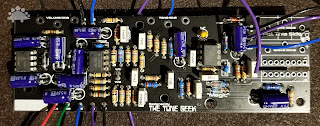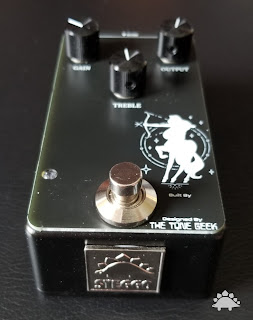As my primary computer is still down, that has hampered my ability to work on enclosure art (as that system has my copies of Photoshop and Illustrator) which has in-turn hampered my ability to get projects done. Fortunately, much like his Valve Screamer, the "Mini-taur" has a faceplate that you can simply put on top of the enclosure - no decals or UV printing required! As you can see from Ryan's image above, the PCB itself is fairly compact and has all of the normal components you'd expect in a Klon clone - they're just rearranged on a two layer board and compressed for space.
My BFK build (shown above) has a mixture of carbon and metal film resistors, just like the real thing. However, it uses modern box film capacitors rather than the old Panasonic style brown blob film capacitors. Then there are the normal electrolytic capacitors and one tantalum capacitor. The ICs are also fairly standard: two TL072 and one ICL7660SCP (the original Klon used a TC1044 - which is a bit harder to get). I used Russian D9E diodes for this build, but I didn't check the forward voltage drop on them. At the end of the day, it is a reasonable copy of the Klon / Ceriatone Centura in all practical respects. The off-board wiring is even the same! So since I'd already done a fairly faithful copy of the Klon itself, I decided to do something a little different with these builds.
In the photo above is my first build that is going to a friend. Gone are the carbon resistors and all of them are replaced with metal film resistors. I did this primarily because the tolerance of the metal film resistors (1%) is better than the tolerance of the carbon resistors (5%). This means all of the voltages across the board are closer to the design spec. As with the BFK, the film capacitors are of the modern box type, though I did use a few higher end substitutions elsewhere. Rather than MLCC capacitors, I used mica capacitors for the 390pF and 820pF capacitors. The electrolytic capacitors are all Nichicon, but the 47uF capacitors are now organic polymer rather than electrolytic. As I was building out my parts list at Mouser, Ryan had an even "higher end" suggested parts list (oooh, foreshadowing) and I pulled these parts from that list as I didn't have any existing stock handy. He also suggested finding germanium diodes with a 0.35V forward drop. For this build, I picked up several D2D diodes from Pedalhacker, and measured them on the multimeter until I had a couple at or near 0.35V.
The IC loadout is the same as in the BFK - two TL072 and one ICL7660SCP, and all of the other diodes are either new production or NOS. The enclosure is a repurposed from another project, so the top actually has a couple of extra holes it it. You can't see them because of both the faceplate and the PCB underneath hides the evidence - but no sense wasting an otherwise perfectly good enclosure. Once I wired it up it fired up and compared well in tone to the BFK and a couple of other little projects I have lying about for future blog entries!
As with all of my new builds, this one has it's "Steggo" maker's mark on it. I went ahead and used some nice black knobs and a dress nut for the stomp switch. The LED itself is purple to match the rest of the enclosure. I guess I'm hoping at this point that my friend likes purple - forgot to ask! So with one pedal down, it was time to tackle the next one!
As I'd mentioned earlier, Ryan the Tone Geek had put together a "high-end" BOM of parts to create the ultimate clone. I decided I'd give it a shot to see how much of a difference it makes in the end. From the photo above, you'll immediately notice a few things - like the resistors. How much more black could they be? The answer is "none... none more black" - well, I guess technically they could not be marked, but then it would be a real pain to actually use, so I'll stick by the "none more black" statement for all practical purposes. These are TE Connectivity metal film resistors with tolerances of either 1% or in some cases 0.1%. I think there may have been one error in the BOM because one of them was a 1/8W rather than a 1/4W - however since there was only one, I went ahead and substituted in a Yageo 1/4W 1% 422K resistor I had on hand to ensure that I had at least 1/4W resistors across the board (the one blue one sticking out like a sore thumb next to the holes for the Gain pot).
The film capacitors are as above, but many of the electrolytic capacitors have been replaced with film capacitors as well. I brought forward the silver mica and organic polymer capacitors I used on the previous build. The only remaining electrolytic capacitors are bipolar, and there is of course the tantalum capacitor characteristic of the original Klon. The ICs have been upgraded as well. Instead of the TL072CP, this one has LT1057 op amps - these have a bit more bandwidth and phase inversion protection as compared to the TL072. Also gone is the ICL7660, in its place is an actual TC1044 - though it is a new production unit. The Zener and protection diodes are the same as above, but according to the Electrosmash analysis of the Klon the right germanium diode to use is a 1N34A. They quote Centaur designer Bill Finnegan:
"I have always used a germanium diode with the part number 1N34A, but you should understand that this particular part has since the 1950s or so been manufactured by literally hundreds of different companies, and having listened to as many different ones as I have, I can say with confidence that they all sound somewhat different in my circuit, and often they sound VERY different."
So, armed with that information, on this build I used 1N34A diodes from Pedalhacker. Once again I went through several and found two that had a forward voltage drop as close to 0.35V as possible. Many of them came in at the 0.30V - 0.31V range, but I did find a couple right at 0.34V (and some change).
Given the population of "none more black" resistors, I decided to just go ahead and carry the theme through to the enclosure as well and go with a "none more black" 125B box. This is just a matt black box from Tayda that I had them custom drill for the project. I've only started testing it, but this thing is amazingly cool so far. The sound is clean with no hiss or noise that I can discern coming from the pedal. Granted I've only tested it at the very front of my fairly long pedal chain, so there are impedance mismatches that will likely have to be considered.
Once I get a couple of decent riffs down that will really show off a Klon, I'm hoping to do a sound comparison including two of these (the purple one is getting delivered early next week) as well as several other DIY takes on the Klon with actual sound samples. I'll have to work on the set up to make sure I can get a real apples to apples comparison of the various pedals. I've seen Anderton's do a video like this, so I may try and figure out how they set up the 10 clones, well, 9 clones and one real deal, for comparison.











No comments:
Post a Comment